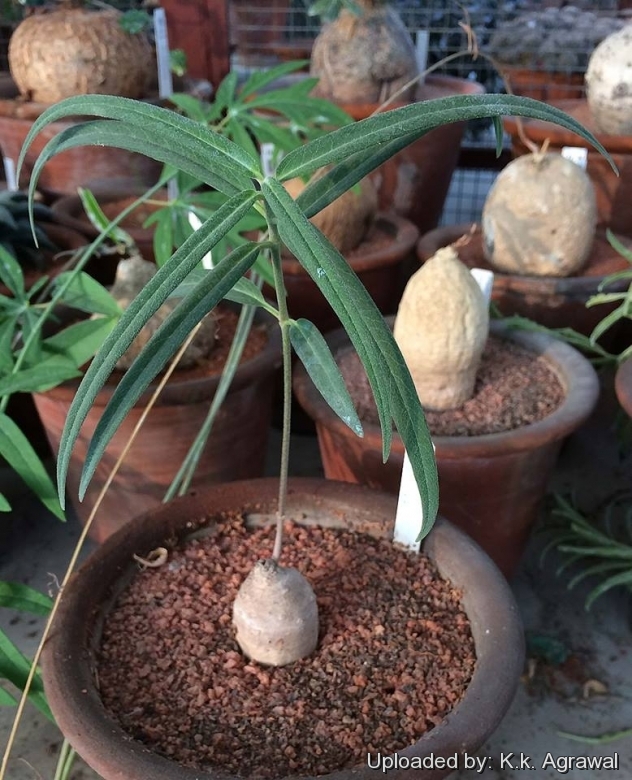Accepted Scientific Name: Stathmostelma gigantiflorum K.Schum.
Bot. Jahrb. Syst. 17(1-2): 129. 1893 [9 May 1893]

Asclepias gigantiflora (Stathmostelma gigantiflorum) Photo by: K.k. Agrawal
As the name suggests, it should come out with a very very big flower !!!
Origin and Habitat: Tanzania and Kenya.
Habitat and ecology: It grows dotted in seasonally inundated meadows. Flowers in the middle of rains.
Synonyms:
See all synonyms of Stathmostelma gigantiflorum
back
Accepted name in llifle Database:Stathmostelma gigantiflorum K.Schum.Bot. Jahrb. Syst. 17(1-2): 129. 1893 [9 May 1893]Synonymy: 6
back
Description: Stathmostelma gigantiflorumSN|30200]]SN|30200]] is an erect herb, up to 1 metres high, with annual stems arising from stout, perennial, subterranean vertical root tubers (geophytic). Flowers are large and showy (5 or more cm wide), white violet in 2 to 4-flowered heads at the tips of branches in summer.
Stems (annual shoots): Spreading but branched from just above base, attaining a height of 30-100 cm, compressed, glabrous, apically weakly pubescent. Latex white.
Rootstock: The tuberous rootstock often referred as a caudex is single, stout, c. 8 cm in diameter, rounded or cylindrical up to 50 cm long, subterranean and vertical. In habitat the fat rootstock grows buried in the ground, but in cultivation, once the tuberous root develop, the plant is partially lifted above soil level and replanted with tuber exposed making a very showy bonsai-like specimen.
Leaves: Sessile or obscurely petiolate, herbaceous, 15-25 cm long, 5-10 mm broad, elongate-lanceolate or linear, acuminate, glabrous, pubescent on the revolute margins and midrib.
Inflorescences (umbels): Solitary, lateral, extra-axillary, and terminal, 2-4-flowered. Peduncles longer than pedicels. Peduncles 2.5-18 cm long, pubescent along one side. Bracts 4-16 mm long, linear, pointed, margins ciliate. Pedicels 2-5 cm long, pubescent along the inner side. Sepals 9-16 mm long, 3–7 mm broad, lanceolate or ovate, acute, basally rounded, glabrous or more or less pubescent on the back. Corolla rotate, mauve-coloured, 4-6 cm in diameter or rather more, flat; lobes 20-28 mm long, 8-10 mm broad, oblong, pointed, glabrous on both sides. Coronal-lobes arising 3 mm above the base of the staminal-column and much overtopping it, 9-16 mm long, ± rectangular, complicate in the apical part, solid below, obliquely truncate, with the inflexed margins produced into falcate teeth, curved upwards over the tips of the anthers, no horn within. Gymnostegium 11-12 mm. Anthers 4-5 mm in the grooves of the styles head; Pollinia bean-shaped, translator arms 4.5 mm long, appendages tapering to a thin filiform portion.
Fruit (mericarp): Solitary, erect, on straight pedicels, narrowly fusiform 10-16 cm long, 5-8 mm broad.
Seeds: c. 3 mm long, 2 mm broad.
Bibliography: Major references and further lectures
1) N. E. Brown. “Flora of Tropical Africa” Vol 4, Part 1, page 231, 1904
2) Focke Albers, Ulrich Meve “Illustrated Handbook of Succulent Plants: Asclepiadaceae: Asclepiadaceae” Volume 4 Springer Science & Business Media, 2002
3) «Stathmostelma». In: “The Genera of Asclepiadoideae, Secamonoideae and Periplocoideae (Apocynaceae): Descriptions, Illustrations, Identification, and Information” Retrieval Universidad de Bayreuth. Web. 16 Jan. 2015.
Cultivation and Propagation: Stathmostelma gigantiflorumSN|30200]]SN|30200]] is an interesting addition to a collection, but rarely seen in cultivation.
Growth rate: It grows well, though very slowly, but it possible to increase the speed of growth to some extent by providing adequate amount of water, warmth, and fertilizer during the active growing season, but it’s susceptible to rotting if too wet.
Exposure: It needs light shade, but the caudex should be in the shade, while the leaves prefer some sun. Avoid direct blasting sun in summer. Bright light if grown indoors.
Soil: In pots it needs a very porous potting medium (add pumice, vulcanite, and perlite). It does better in a rather acidic soil.
Waterings: Water frequently while plant is in full growth, but keep dry during the winter after the branches have died back. It rot easily and do NOT like a lot of water when it has no leaves.
Fertilizer: Benefits from moderate doses of a well-balanced, slow-release fertilizer.
Frost tolerance: Due to its African origin keep warm in winter, the minimum safe average temperature is 15°C, although it can go lower for short periods. It can be grown outdoors in frost-free climates, need anyway to kept above 10°C and dry in winter. It is very prone to rot in cool, wet conditions. USDA Zone 10-12, but does very well in containers.
Manteinance: Repot every two years. It like pots with generous drain holes. In the winter, the vining branches die back and should be cut back to encourage branching, to maintain an attractive shape and to ensure caudex habit.
Propagation: The species can be propagated by seeds (and cuttings ? too). The plants for decoration are grown from seed since they develop a caudex.











